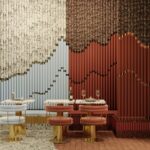Architect Gunveer Singh
Architect Gunveer Singh talks about environmental architecture and its importance for an inclusive future with The Tiles of India. Gunveer Singh” graduated with a Master in Architecture in Sustainable Environmental Design from the Architectural Association, London, and is a LEED BD+C, practicing as an Environmental Designer with design and analytical experience in the field of sustainable architecture in India and the UK. He is research-driven and has been an external reviewer for the master’s program at the Architectural Association, London, and currently takes environmental design tutorials at UCL, London.
The Tiles Of India in a tête-à-tête with Architect Gunveer Singh
Tell us about your journey. How did it all start?
Let’s start by saying that I am quite young in the profession. My “architectural journey” started in 2011 when I decided to pursue the field. But my professional journey started in 2018. My career path initially has been research-driven. I took up a topic regarding the 24/7 offices in India and researched factors affecting their operation and presented papers at the NCEUB conference in London and PLEA conference in Hong Kong. So, the mindset and peaked interest in a performance-oriented and analytical approach to architecture became the core of professional practice. Then I practiced at Atmos Lab, London as an environmental consultant, working on live and competition projects across Europe by renowned architecture firms like Bruther, Lacaton et Vassal and Office KGDVS, providing them analytical data for design optimization. Currently, I am working in collaboration with Ashok Lall Architects in Delhi and have been taking lectures and workshops at BSSA, Mumbai, and UCL, London as an Environmental Design tutor.
What inspired you to choose environmental design?
In the 3rd year of my bachelor’s, I used to hate the topic of environmental designing and climatology, and my interest developed in the 4th year. At times I used to wonder why that happened and I soon realized that the reason for such a drastic shift happened when I started getting hands-on experience and applying the theory into practice and how it really morphed my designs. My internship at Ashok Lall Architects in 2014 was the catalyst that really cemented the ideology and then over the years, it’s more about evolving and analyzing the principles by quantifying the various performance indices to achieve something remarkable.
What is sustainable architecture according to you? How does it impact the overall design ideology?
Architecture is a field that is driven by art, science, and commerce but as architects, we seldom focus on the scientific aspects of design, and sustainability in our practice is driven by the scientific aspect.
Personally speaking in the current scenario, the real meaning of sustainability is lost. Its been used as a marketing gimmick in certain parts of the industry and that’s why I prefer saying Environmental Design or Enviro[ARCH] for me sustainable architecture should be able to sustain the climatic changes that we are experiencing. But rather than architectural design optimization, many talks in terms of system optimization and that’s where the issue lies. As architects, our designs should provide comfort and post-occupancy performance efficiency, and the innovation in how we achieve the efficiency should be the basis of the architectural practice.
Environmental Architecture or Enviro [ARCH] should be taken as an architectural challenge that emphasizes a performance-based design that focuses on occupant comfort, thus making the artistic aspect scientifically plausible.
The idea starts by understanding that environmental designing is an integrative and iterative process where the architects and consultants need to work together from the conceptual stage.
Such an approach helps design environments by responding to the contextual needs of the site and takes the wide range of thermodynamic exchanges for adaptive comfort into account, moving away from the idea of the 24oC threshold that was articulated in the 1950s, which resulted in heavy reliance on the mechanical systems.
What is needed to move the mainstream towards sustainable buildings? What is the next evolution in design?
I believe the industry can benefit from the evidence-based approach, by simulating scenarios and design strategies before being built. In the case of retrofitting as well, the technology available today could help immensely in making our designs adaptable to the ever-changing climate. One can monitor the operational conditions using BMS systems and the sensors available these days, make our building operation occupant centric.
In order to evolve, we need first to accept the change and try and adapt and adopt. At the end of the day, we as professionals need to realize that we cannot give the visual sense a priority over other senses. How comfortable we feel in a space is as important as how space looks. The overreliance on mechanical systems to cool down a hot box is not a good design. One should use technology to improve the performance of the building so that it can adapt to changing conditions. With the current knowledge, we can erect buildings that are net-zero, without compromising on spatial excellence where occupants would enjoy and respond positively to the built environment.
What are the most pressing issues for architects in India when it comes to the sustainable building? How are you addressing them?
I think the ideology needs to start at the very grassroots of design. One thing that really amazed me while taking the tutorials at UCL is that the students were being introduced to the environmental design concepts and were encouraged to research alternate construction materials during the first year of their study. Topics like environmental design can be understood when you see and feel the difference certain design moves make and are able to quantify the results. In the current data-driven age, students should be taught programs that can help them analyze the changing surrounding and the climate conditions and made to interact with practicing professionals with different disciplines of the field.
Democratizing the knowledge is really important. Initiatives like the Solar Decathlon that took place this year or the one started by DigitalFUTURES World where they call architects and instructors across the globe to come together in a spirit of solidarity to offer a series of workshops available for free to students across the globe. In this Year’s event Inclusive FUTURES, I will be conducting the workshop to teach the students various techniques to analyze and quantify design parameters, and I have received an overwhelming number of applicants from across the globe, ranging from bachelors to Ph.D. students, thus showing evidence of shifting approach.
Also, in order to move the mainstream towards sustainability, it is important to enforce policies that promote the idea of efficiency. In this pandemic period, the over-reliance on just mechanical systems has poised more issues than a solution because of inefficient designing.
What are your plans for the future?
My aim is to continue with academic democratization and carrying on initiatives like these along with my professional scaling because I truly believe in it. The 2050 target that has been set, we as young professionals will be living it and will also be responsible for achieving the target and I hope that through my practice and future collaborations, I am able to make a meaningful contribution.
Contact Details:
www.GSDesignlab.com



